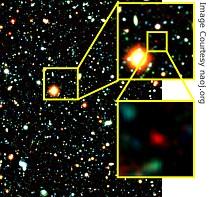2006年VOA标准英语-Astronomers Detect Earliest Galaxies(在线收听)
By David McAlary
Washington
14 September 2006
Astronomers have found that the universe began lighting up in its infancy. They have observed the most distant and oldest galaxies ever seen, small galaxies that helped lift the cosmos out of its dark ages.
--------
 A series of images zooming in on Galaxy IOK-1, the reddish object in the center of the last panel, currently the most distant known galaxy about 12.88 billion light years away |
||
Two studies in the journal Nature suggest that galaxies were forming when the universe was only six percent of its present age. That would be not long after the so-called Big Bang, the cataclysmic explosion nearly 14 billion years ago, thought to have created all matter from an ultra-dense mass the size of a pinhead.
In one paper, Japanese astronomers, led by Masanori Iye of the National Astronomical Observatory in Tokyo, report discovering the farthest galaxy yet seen.
"It is an object 750 million years after the Big Bang," he said. "This is the most distant, single, identified object a human being has ever discovered."
Iye's team used the Subaru telescope in Hawaii. They confirmed the age and distance of the galaxy by its redness. The redder an object is, the farther away it is. This is because light from receding bodies shifts downward into these lower light frequencies, just as the sound of a passing car horn drops in pitch.
Iye told Nature magazine interviewers that few galaxies existed at that primordial time.
"To our surprise, the actual number of distant galaxies at 750 million years after the Big Bang was only one-third to one-sixth of what we had expected," he added. "This decrease could be due to the evolution of the galaxy itself. So, we have to study more carefully, looking into different directions of the universe, and looking also deeper into fainter population of galaxies."
Another group of astronomers, using the Hubble Space Telescope, also found galaxies a rarity in the infant universe. They looked slightly earlier, at about 700 million years after the Big Bang.
"What we've found is that, at the very earliest epochs of the universe, there seems to be a very significant deficit of luminous galaxies," said Richard Bouwens of the University of California at Santa Cruz. "The universe is simply not old enough to have allowed these luminous massive galaxies to have formed."
When Bouwens' team peered at galaxies from a later period, when the cosmos was about 900 million years old, they found many more - hundreds of them. The results of both studies support the idea that galaxies built up from much smaller pieces, when the universe was between 700 million and 900 million years old.
"The universe wouldn't necessarily look that much different than it does today, except that the galaxies that existed would be in much smaller pieces," he added. In the universe that we see today, there are lots of very big ones, but way back then, the galaxies would be very much smaller."
It is as if the baby universe experienced a growth spurt after 700 million years.